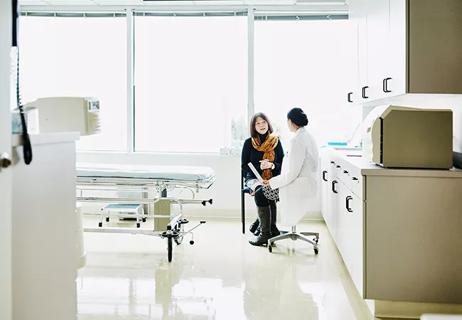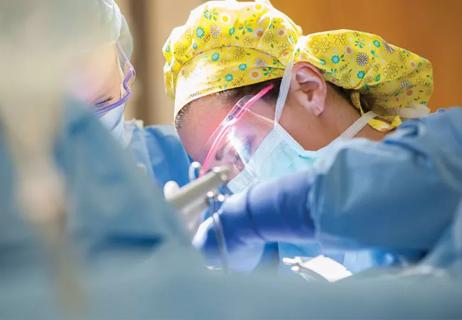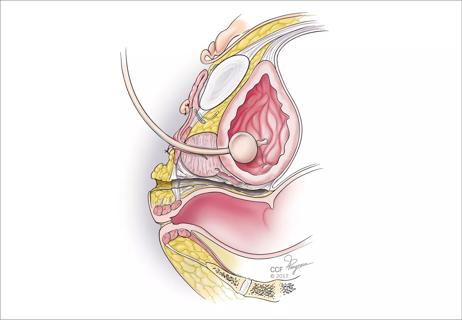Study findings lead to changes in practice

Prolapse or herniation of the pelvic organs can interfere with a woman’s quality of life by negatively affecting activities of daily life and exercise. Parity, advancing age and obesity are all known risk factors for the condition, which is common. Even after sacrocolpopexy, pelvic organ prolapse can recur, but research on the risk factors is limited. A new study aims to fill that gap and has identified one potential risk factor.
Cleveland Clinic is a non-profit academic medical center. Advertising on our site helps support our mission. We do not endorse non-Cleveland Clinic products or services. Policy
“Our study is novel because it specifically looks at the question of risk factors for recurrence after sacrocolpopexy,” says Olivia Chang, MD, MPH, a fellow in the Cleveland Clinic Center for Urogynecology & Pelvic Reconstructive Surgery and first author on the study. “We were able to generate results that may help other researchers.”
“What we found is that a genital hiatus size of 4 cm or more is a risk factor for prolapse recurrence after sacrocolpopexy, which is quite consistent with the literature for any pelvic organ prolapse surgery,” she noted. “The other thing we found is that posterior repair at the time of sacrocolpopexy was actually a protective factor and patients who had such a repair had 40% lower odds of developing prolapse recurrence. “
The study included a retrospective chart review and prospective follow-up survey of 709 women who underwent laparoscopic, robotic, or abdominal sacrocolpopexy from 2004 to 2014. The subjects had a mean age of 59 years and body mass index of 27.2 kg/m2.The majority of patients in both groups (62.2%) had stage III pelvic organ prolapse.
Cases were patients who had a composite failure, defined as subjective bulge symptoms, retreatment or anatomic prolapse (stage II or greater prolapse on POP-Q). POP-Q (Pelvic Organ Prolapse Quantification system) is an objective, site-specific system approved by the International Continence Society, the American Urogynecologic Society, and the Society of Gynecologic Surgeons to describe female pelvic organ prolapse. With POP-Q, six anatomic points — three anterior (Aa, Ba and C) and three posterior (Ap, Bp and D) — are used as reference for measurements. The cases were matched with control patients who had no composite failure in a 1:4 ratio.
For the retrospective part of the study, the authors collected demographic and perioperative data from the patients’ medical records. For the prospective portion of the study, patients were surveyed about their symptoms and retreatment of complications after survey.
Median anatomic follow-up was 204 days and mean survey follow-up time was 2,492 days in both groups. The women with composite failure of sacrocolpopexy were younger (56.8 vs. 59.2 years; P = 0.004), more patients a genital hiatus that was 4 cm or larger before their surgery (84.3% vs. 72.4%; P = 0.004) and more patients had an anterior repair the same time as their sacrocolpopexy (11.1% vs. 5.3%; P = 0.001).
“We were surprised that anterior colporrhaphy at time of sacrocolpopexy was a risk factor for prolapse recurrence,” says Dr. Chang. “After analyzing our results, we determined that in patients who require anterior colporrhaphy at time of sacrocolpopexy, it’s often because they have inadequate suspension in the anterior compartment.”
Logistic regression confirmed that a genital hiatus of 4 cm or larger (adjusted OR 2.00, 95% CI 1.22-3.38) and concurrent anterior repair (adjusted OR 2.12, 95% CI 1.06-4.15) were both preoperative risk factors for composite failure of sacrocolpopexy. Conversely, having sacrocolpopexy at an older age (adjusted OR 0.97, 95% CI 0.95-0.99) and a concurrent posterior repair (adjusted OR 0.62, 95% CI 0.42-0.93) were both associated with lower risk of composite failure.
“Our interpretation of this study’s results is that the need to perform an anterior repair should alert surgeons to consider extending the anterior portion of the mesh to provide more adequate suspension, as we demonstrated that an anterior repair alone is not sufficient to protect against prolapse failure. Posterior repairs were found to be protective at the time of sacrocolpopexy, which adds to the existing literature,” says Cecile Ferrando, MD, MPH, Associate Program Director of Cleveland Clinic’s Female Pelvic Medicine & Reconstructive Surgery Fellowship program and senior author on the study. “The next step in our research would be prospective trials so we can determine whether posterior repair at time of sacrocolpopexy is truly a protective factor.”

Deprivation is linked to impaired glucose intolerance and racial disparities

Artesunate ointment is safe well and tolerated patients with vulvar intraepithelial neoplasia

A case-based discussion of efficacy, eligibility and use

Workshop curriculum was valued by some, while others would have preferred time for themselves

Study finds lower incidence of endometriosis than in cisgender patients

Large randomized study compares embryo growth kinetics and live birth rates between culture media

Surgeon experience is key to reducing adverse events

Introducing Laura Detti, MD, newly appointed Chair of the Department of Subspecialty Care for Women’s Health